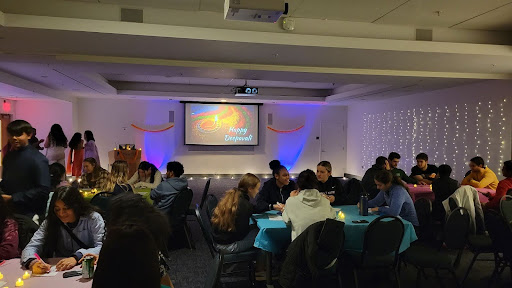
On Nov. 4 the SUNY New Paltz South Asian Cultural Association (SACA) joined together with the International Student Union (ISU) to put together the school’s Diwali celebration in SUB 62/63. This occasion marked SACA’s first major event of the 2024-2025 school year. Festivities included music, traditional dancing, games and authentic Indian food.
Diwali is a major Indian holiday celebrating the Festival of Lights that happens around their lunar New Year. However, it’s a much more layered tradition than a typical New Year celebration. “We don’t celebrate it in ways that you typically think of here,” said SACA co-president Sana Anand.
“There’s a whole story surrounding it called the Ramayana about a prince from a vital city in India who was exiled through unfair reasons to prove his dedication … At the end of his exile, the citizens of his city, they loved him so much. They were so glad he was back, they hung lights on the sides of their houses to light his way home.”
Much like the story, the walls of the room were adorned with multi-colored lights that brought the beauty of the Festival of Lights straight to New Paltz. Not long after the event started, the room was filled with students coming together in celebration of India’s premier holiday.
The event’s feeling of cultural authenticity wasn’t lost for a moment. Many event-goers showed up in traditional Indian garbs, as encouraged by the open invitation on the ISU’s Instagram account. “Girls, don’t be afraid to wear your heaviest lehenga,” read the post, followed by: “Boys, bring out that shiny kurta!”
Festivities increased as the event continued. Early into the celebration, ISU E-board members surprised audience members with traditional Indian performance art. Two members performed a traditional Nepali dance, complimenting each other’s dancing with smooth, fluid motion and synchronizing when demanded by the dance.
Attendees continued to fraternize, sharing nostalgic memories of Diwali celebrations from childhood. Some students from overseas shared feelings of homesickness, balanced by the joy and relief of being able to continue their traditions. “It’s great to have [international students] because they’re so passionate about it, because they feel so far from home and like, this is how you get to celebrate,” Anand said.
Before long, the room was full of eager event-goers enjoying each other’s company and creating colorful Rangoli art. Food was eventually made available, treating SUNY New Paltz students to a variety of traditional Indian cuisine. Such foods included vegetable biryani, a rice dish with various herbs and spices, samosas, a common fried snack in South Asia and chili paneer, a dish that combines various sauces to create something that is sweet, spicy and tangy all at the same time. During this time, event-goers were free to enjoy the celebratory and high-energy Indian pop music that played triumphantly from the room’s speakers.
Long-time celebrators of the Diwali tradition were free to express their sentimentality for the holiday via a memory board. This memory board was covered in sticky notes depicting various messages, some meant for friends and family, others simply wishing for a happy Diwali for everyone or expressing wishes for themselves, fellow attendees and humanity at large. One such note expressed someone’s wishes for the upcoming year, reading “I wanna find my true love.” Another note sent well wishes to the reader, reading “May you find everything you desire this Diwali. Sending you all lots of love! XOXO.” Another note carried a very similar sentiment, reading “May ya have a beautiful year and find love where ya need it.”
Of course, no holiday celebration is complete without its share of games. During the event, attendees played a musical chairs-type game called “Fire on the Mountain.” During this game, players formed a large circle around a host in the front of the room. As music began to play, the circle rotated and players were tasked with forming groups with one another during this time. When the music stopped each round, the host would call out a number, and if a player’s group contained that number of people, they were all out. This game only lasted several minutes but kept festivities alive with smiles and laughter from participants.
As the event neared its end, people took group pictures among the lights and continued to enjoy the high-energy Indian dance music. During this time, ISU Vice President Sasha Bansal provided further details on the cultural contexts and folklore surrounding Diwali. “Diwali is celebrated around 12 to 14 days after the day Lord Rama was killed in Sri Lanka, [because] it took around 12 days to come back to Ayodhya, where he was born. And then, Ayodhya was decorated with a lot of lights for the homecoming of Lord Rama.”
Classic legends telling of a deity’s death and rebirth are commonplace in many religions and belief systems around the world, and this one is no different. Bansal further explained how the traditions of Diwali connect to the gods of Indian folklore: “We decorate the place. We clean the place in respect to Lord Rama coming home, and we worship the deity Lakshmi and Ganesha. Ganesha is the elephant god and Lakshmi is the goddess that sits on the lotus flower. And Ganesha is the lord of good health, and Lakshmi is the goddess of prosperity. Diwali is the biggest festival that Indians have. We clean our homes. We decorate our homes. We wear new clothes. We give sweets. We go with friends and family. We have a worshiping ceremony.”
Those interested in joining SACA can attend one of their meetings held bi-weekly on Thursdays at 7 p.m. in SUB 401. ISU meetings can be found in SUB 402 every Wednesday. Further information on upcoming events and happenings can be found on their Instagram pages, @isusunynewpaltz and @npsaca.

Leave a Reply
You must be logged in to post a comment.